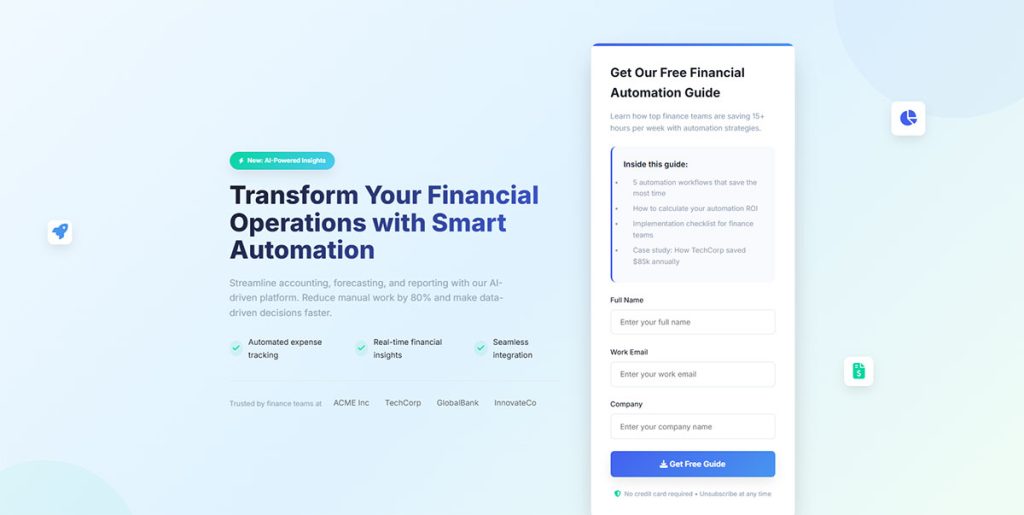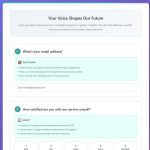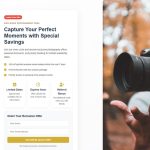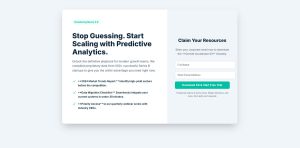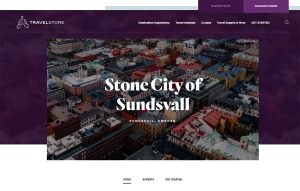Empty treadmills don’t pay bills. Fitness centers compete against Planet Fitness, Anytime Fitness, and boutique studios on every corner. Lead generation for gyms separates the survivors from the closures. The…
Table of Contents
Your email list won’t grow itself. Without effective lead magnet best practices, you’re basically asking strangers to hand over contact information for nothing in return.
Most businesses throw together generic PDFs or outdated checklists, then wonder why conversion rates hover around 2-3%. The data tells a different story—optimized lead magnets convert at 18% on average, with top performers hitting 34% or higher.
This guide breaks down 18 proven strategies for creating high-converting subscriber incentives. You’ll learn what actually works this year, from targeting specific problems to optimizing your email opt-in form and landing page design.
Each practice includes concrete implementation steps, conversion impact data, and common mistakes that kill performance. Stop guessing and start building lead magnets that turn visitors into engaged subscribers.
Lead Magnet Best Practices
| Practice Category | Core Attribute | Implementation Focus | Success Metric |
|---|---|---|---|
| Solve one specific problem | Problem specificity | Address single pain point with targeted solution | Problem-solution alignment score |
| Deliver immediate value | Value immediacy | Provide actionable outcome upon download | Time-to-value (minutes) |
| Keep it short and actionable | Content density | Prioritize implementation steps over theory | Completion rate |
| Use a compelling title | Title effectiveness | Communicate benefit and outcome clearly | Click-through rate from headline |
| Make it easy to consume | Consumption friction | Optimize for scanning and quick comprehension | Average engagement time |
| Ensure high quality | Quality perception | Professional design with error-free content | Brand trust elevation |
| Align with your main offer | Offer congruence | Create logical progression to paid product | Lead-to-customer conversion rate |
| Include a clear call-to-action | CTA clarity | Direct user to specific next step | CTA click rate |
| Optimize the landing page | Page performance | Minimize form fields and reduce friction points | Landing page conversion rate |
| Make it visually appealing | Visual hierarchy | Use whitespace and formatting for readability | Visual satisfaction score |
| Target your ideal customer | Audience specificity | Address pain points of defined persona | Lead qualification rate |
| Promise and deliver quickly | Delivery speed | Automate instant email delivery | Delivery-to-open time |
| Use social proof | Credibility signals | Display testimonials and download counts | Trust indicator impact |
| Make it easy to access | Access simplicity | Reduce steps between signup and content | Download completion rate |
| Test different formats | Format optimization | Experiment with PDFs, videos, templates | Format preference data |
| Gate it properly | Gating balance | Request only essential contact information | Form abandonment rate |
| Follow up promptly | Response velocity | Send nurture sequence within 24 hours | Follow-up engagement rate |
| Track conversion metrics | Measurement precision | Monitor full funnel from view to customer | Attribution accuracy |
Solve One Specific Problem
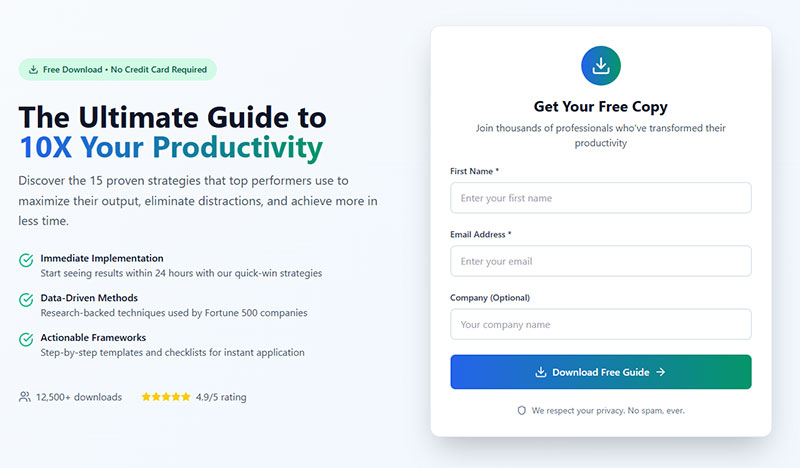
Your lead magnet needs a laser focus. Trying to fix everything dilutes value.
Core Implementation
Target a single pain point your target audience faces daily. Research customer support tickets, social media comments, and sales calls to identify recurring frustrations. Frame your offer around solving that one issue completely rather than touching multiple topics superficially.
Impact on Conversion
Specific problem-solving increases perceived value and download rates. Checklists addressing narrow issues convert at approximately 34%, while generic resources struggle to reach 10%. People exchange contact information when they see immediate relevance to their situation.
Common Mistakes
Creating resources that try to be comprehensive guides instead of focused solutions. Marketers often expand scope thinking more content equals more value, which actually reduces conversion rates. Another error is solving problems prospects don’t actually have based on assumptions rather than research.
Optimization Criteria
Track which pain points generate the highest email opt-in form submissions. Monitor post-download engagement to confirm the resource actually solved the stated problem.
Deliver Immediate Value
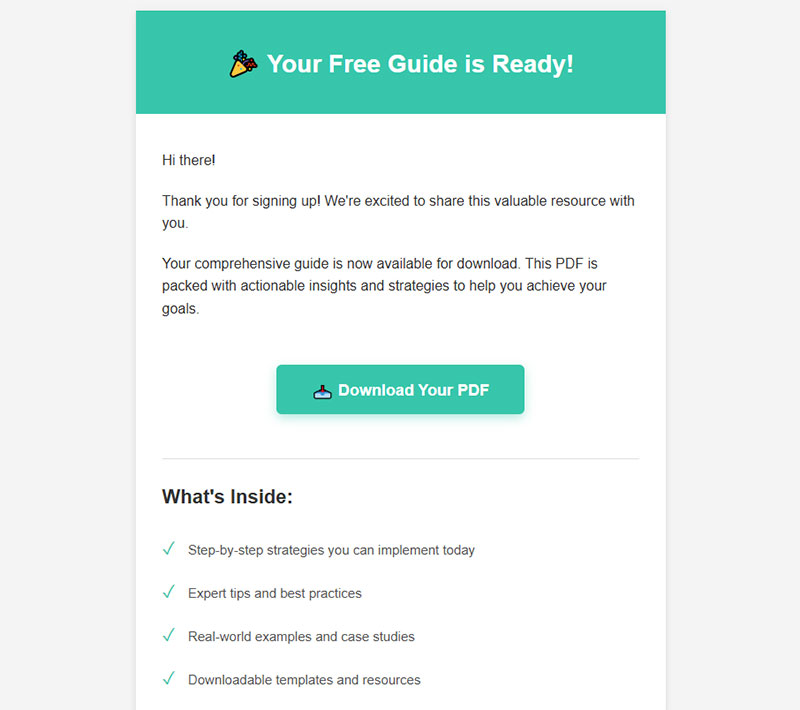
Nobody wants to wait three days for a PDF.
Core Implementation
Set up automated delivery through email marketing platforms that send download links within 60 seconds of form submission. Host files on reliable servers with fast load times. Include the complete resource in the first email rather than requiring additional steps.
Impact on Conversion
Instant delivery maintains momentum and trust. A 25-35% improvement in conversion rates occurs when companies implement systematic follow-up processes compared to delayed delivery. Prospects abandon the process entirely when fulfillment takes longer than expected.
Common Mistakes
Requiring email verification before sending the download link, which adds friction and reduces completions by roughly 15-20%. Sending a “thank you” email first, then the actual resource in a second message. Breaking the content into multiple parts delivered over several days when prospects expected everything immediately.
Technical Requirements
Email service provider with automation capabilities. File hosting on CDN or reliable cloud storage. Backup delivery method if primary system fails.
Keep It Short and Actionable

Long doesn’t mean valuable. Short-form content consistently outperforms bloated alternatives.
Core Implementation
Limit written lead magnets to 1-5 pages maximum for checklists, templates, and quick guides. Video content should run 3-7 minutes for tutorials and clips. Focus on steps someone can implement within 24 hours rather than theoretical frameworks requiring weeks to execute.
Impact on Conversion
73% of marketers report higher conversion rates with short-form video content compared to webinars or long recordings. For written materials, 58.6% see better results with newsletters and checklists versus comprehensive reports. Quick wins build trust faster than extensive resources that sit unread.
Common Mistakes
Padding content to hit arbitrary page counts because “longer seems more valuable.” Including background information and context that delays the actionable material. Forcing people through 40-page whitepapers when a two-page checklist would actually get used.
Optimization Criteria
Measure completion rates, not just downloads. Track how many recipients actually use the resource versus filing it away.
Use a Compelling Title
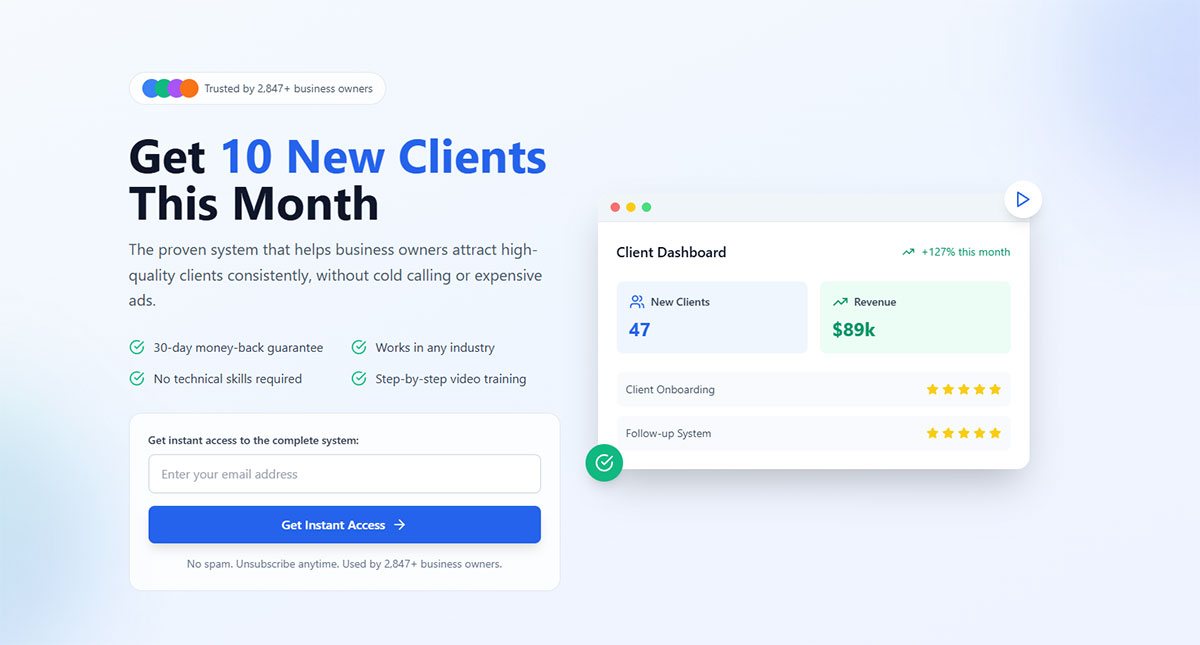
Generic titles kill curiosity.
Core Implementation
Test benefit-driven headlines that specify the outcome rather than describing the format. Use numbers when possible (“7 Ways to…” performs better than “Ways to…”). Include power words that trigger emotional responses like “proven,” “ultimate,” or “secret” when genuinely applicable. The title should answer “what’s in it for me” within three seconds.
Impact on Conversion
Headlines directly influence whether prospects even read your landing page copy. A/B testing headlines alone can shift conversion rates by 20-30% without changing anything else. Specific, curiosity-driven titles outperform vague descriptors consistently across industries.
Common Mistakes
Using insider jargon that target customers don’t actually search for or understand. Making promises the content can’t fulfill, which damages trust even if it increases initial downloads. Choosing clever wordplay over clarity when prospects need to instantly grasp the value.
Make It Easy to Consume
Nobody wants homework disguised as a freebie.
Core Implementation
Use scannable formatting with bullet points, numbered lists, and clear subheadings. Include visual elements like screenshots, diagrams, or icons to break up text density. For video lead magnets, add timestamps and chapters so viewers can jump to relevant sections. Design for mobile consumption since many people access resources on phones.
Impact on Conversion
Well-formatted resources see higher engagement and sharing rates. Visual lead magnets capture 11.8% of high-converting formats. When content looks approachable rather than dense, people are more likely to actually consume it and perceive value delivered.
Common Mistakes
Creating walls of text without formatting breaks. Using complex design that makes simple information harder to extract. Requiring special software or accounts to access basic PDF or video content. Ignoring mobile optimization when 40-60% of traffic comes from phones.
Ensure High Quality
Sloppy freebies signal sloppy products.
Core Implementation
Proofread all text for spelling and grammar errors. Ensure design elements look professional even with simple tools like Canva. Fact-check statistics and verify links actually work. Test all download processes yourself before launch. The resource should match or exceed the quality level of your paid offerings in execution, just not in scope.
Impact on Conversion
Quality establishes authority and builds confidence in your main offer. People judge your products and services based on free samples. Poor quality reduces perceived expertise and tanks conversion rates from subscriber to customer down the marketing funnel.
Common Mistakes
Rushing production to launch quickly without reviewing the final output. Using low-resolution images or broken formatting. Providing outdated information that hasn’t been refreshed in years. Treating the lead magnet as less important than paid content when it’s actually your first impression.
Optimization Criteria
Track complaint rates and unsubscribe patterns after delivery. Monitor whether subscribers engage with follow-up emails or immediately disengage.
Align with Your Main Offer
Random resources attract random people.
Core Implementation
Design lead magnets that solve the first step of problems your paid products address. If you sell course creation software, offer a “Course Outline Template.” If you provide consulting services, create a “DIY Audit Checklist” that highlights issues you solve professionally. The resource should make prospects think “if the free version is this good, the paid option must be amazing.”
Impact on Conversion
Aligned lead magnets generate qualified leads who actually need your solutions. Misaligned resources build large email lists with terrible customer conversion rates. Strategic alignment improves lead quality even if total volume decreases slightly.
Common Mistakes
Creating trending content that attracts audiences outside your target market. Offering generic resources everyone provides because they seem like “must-haves” rather than strategic positioning. Solving problems completely unrelated to your product catalog just to boost list size.
Include a Clear Call-to-Action
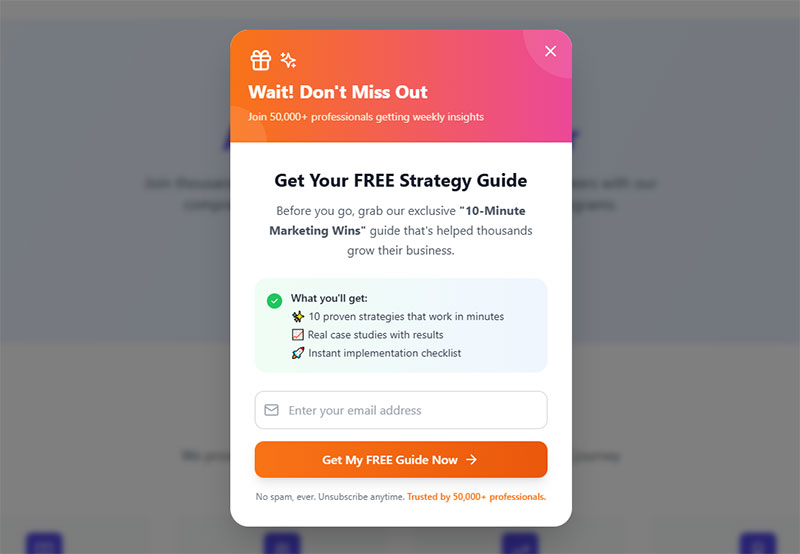
Leaving next steps vague wastes opportunities.
Core Implementation
End your lead magnet with specific guidance on what to do next. This might be scheduling a consultation, checking out a specific product, joining a community, or watching a demo. Make the CTA relevant to the problem they just learned to solve. Include direct links rather than making people search your website.
Impact on Conversion
Strategic CTAs move subscribers deeper into your sales funnel rather than ending the relationship after the download. Companies that incorporate next-step guidance see 30% more progression to paid offers. The lead magnet becomes part of the nurture sequence rather than a standalone piece.
Common Mistakes
No call-to-action at all, assuming people will figure out next steps independently. Pushing hard sales too early before establishing value. Directing everyone to generic homepage URLs instead of specific relevant pages. Including multiple competing CTAs that create decision paralysis.
Optimize the Landing Page
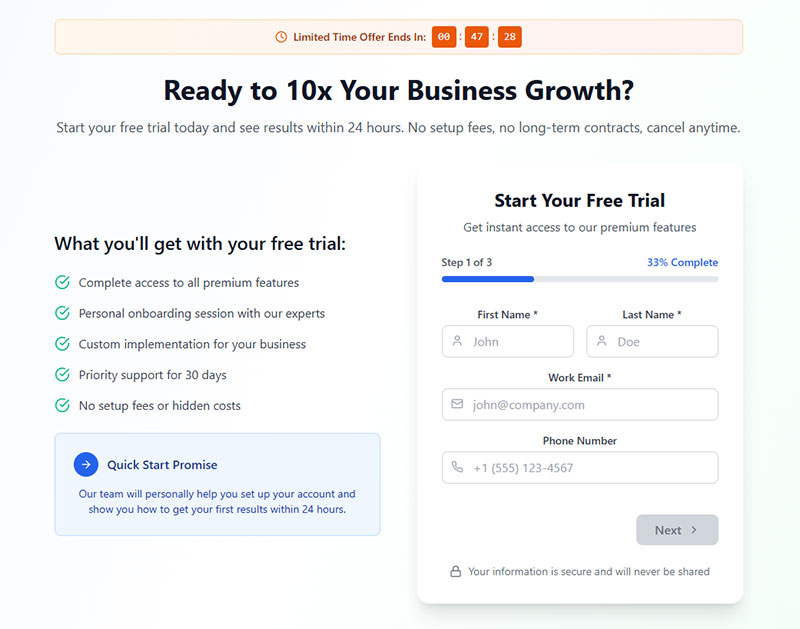
Your landing page forms make or break conversions.
Core Implementation
Remove navigation menus to eliminate exit paths. Place the email opt-in form above the fold so visitors see it without scrolling. Write headlines that state the specific benefit clearly. Use bullet points to highlight what’s included rather than paragraph blocks. Include social proof numbers if available (“Join 47,000 marketers who downloaded this”).
Impact on Conversion
Dedicated landing pages without navigation convert at approximately 18% on average, while coupon pages can hit 82%. Removing distractions and friction points in the opt-in process directly correlates with subscriber acquisition. Small page tweaks can shift performance by 15-25%.
Common Mistakes
Asking for too much information in form fields. Every additional field beyond name and email reduces completions. Including website navigation that lets people browse away before subscribing. Burying the opt-in form below lengthy copy that most visitors won’t read.
Technical Requirements
Landing page builder or website platform that supports form integration. Email service provider connection for automatic list addition. Analytics tracking to monitor conversion metrics.
Optimization Criteria
Track landing page conversion rate (form submissions divided by total visitors). Monitor bounce rate and time on page. Test different headline variations and form placements systematically.
Make It Visually Appealing
Ugly PDFs end up in trash folders.
Core Implementation
Use consistent branding with your company colors and fonts. Include whitespace so pages don’t feel cramped. Add relevant images, icons, or graphics to support key points. Choose readable font sizes (minimum 11-12pt for body text). Create a professional cover page that makes a strong first impression.
Impact on Conversion
Visual appeal influences perceived value and shareability. People judge content quality within seconds based on appearance. Well-designed resources get forwarded to colleagues, expanding reach organically. Poor design makes valuable information seem amateurish.
Common Mistakes
Over-designing with too many colors, fonts, and competing visual elements. Using stock photos that feel generic or irrelevant. Ignoring brand consistency between the landing page and the actual resource. Creating designs that look dated or cheap.
Target Your Ideal Customer

Everyone is not your audience.
Core Implementation
Create buyer personas based on actual customer data, not assumptions. Analyze which market segments have the highest lifetime value and build resources specifically for them. Use language and examples that resonate with that specific group. Consider gating different lead magnets for different audience segments rather than one-size-fits-all approaches.
Impact on Conversion
Targeted resources attract qualified prospects who actually convert to customers. Generic lead magnets build big lists with poor engagement and low purchase rates. Companies targeting B2B and B2C audiences simultaneously see different conversion patterns for video versus written formats.
Common Mistakes
Trying to appeal to everyone by making content vague and general. Using demographic assumptions rather than actual customer research. Creating resources for who you wish your customers were instead of who they actually are.
Promise and Deliver Quickly
Speed matters more than you think.
Core Implementation
Set automated workflows that trigger immediately upon form submission. Use transactional email for delivery rather than marketing sequences that might delay sending. Keep the delivery email simple with a prominent download button or link. Confirm receipt with a “Got it? Here’s your link” approach rather than lengthy welcome messages.
Impact on Conversion
Immediate fulfillment reduces abandonment and increases satisfaction. Delays create doubt about whether the system worked and whether you’ll actually deliver. Fast delivery maintains the excitement that drove the initial signup decision.
Common Mistakes
Manual approval processes that delay delivery by hours or days. Requiring email verification before sending the resource, which adds unnecessary friction. Sending multiple “getting to know you” emails before providing what was promised.
Technical Requirements
Marketing automation platform with instant trigger capabilities. Reliable email deliverability to avoid spam folders. File hosting that handles traffic spikes without slowdowns.
Use Social Proof
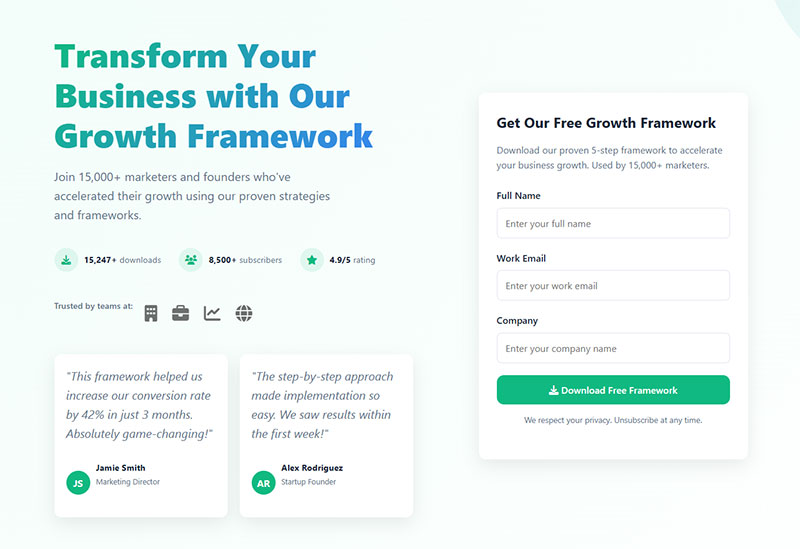
Numbers convince skeptics.
Core Implementation
Display download counts, subscriber totals, or user testimonials on landing pages. Include specific metrics (“Downloaded by 15,000+ marketers”) rather than vague claims. Add customer logos if applicable. Feature reviews or testimonials about the lead magnet itself if available. Keep numbers updated rather than showing stale statistics from years ago.
Impact on Conversion
Social proof reduces perceived risk and validates quality. When prospects see others like them found value, hesitation decreases. Specific audience size numbers work especially well when paired with personality and promised value delivery.
Common Mistakes
Fabricating numbers or testimonials, which destroys credibility if discovered. Using generic praise that could apply to anything. Displaying social proof for unrelated products instead of the specific resource being offered. Letting social proof elements become outdated and irrelevant.
Make It Easy to Access
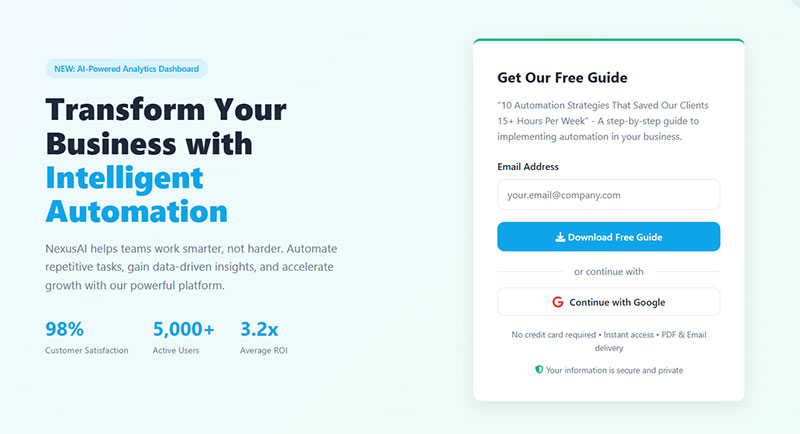
Friction kills conversions dead.
Core Implementation
Minimize required form fields to just email address, or email plus name maximum. Offer social login options like “Continue with Google” to reduce typing. Ensure download links work on all devices and browsers. Provide both download and email delivery options for flexibility. Test the entire process monthly to catch broken links or technical issues.
Impact on Conversion
Reducing barriers increases completion rates significantly. Each additional form field drops conversions by an estimated 5-10%. Quick login options from platforms like Grammarly remove friction and make starting effortless. When people see that millions already trust the offer, hesitation drops.
Common Mistakes
Requiring account creation before allowing downloads. Asking for phone numbers, company size, job titles, and other information beyond basic contact details. Using file formats that require special software to open. Breaking the download process into multiple steps across several pages.
Test Different Formats
What worked last year might flop now.
Core Implementation
Experiment with various content types: checklists, templates, video tutorials, quizzes, calculators, email courses, case studies. Track conversion rates and engagement metrics for each format with your specific audience. Run A/B tests comparing formats head-to-head rather than assuming one type works best universally.
Impact on Conversion
Format preference varies dramatically by industry and audience. Video and written content each capture 24% and 23% respectively of marketer preferences, showing no universal winner. Interactive content like quizzes and calculators can convert at 20-60% in optimal scenarios. Testing reveals what your audience actually prefers versus industry assumptions.
Common Mistakes
Copying competitor formats without validating effectiveness for your audience. Sticking with one format because “that’s what we’ve always done.” Avoiding video because of production concerns when your audience heavily prefers it. Never analyzing which formats drive actual customer conversions beyond initial downloads.
Optimization Criteria
Monitor conversion rates by format type. Track engagement metrics like completion rates and time spent. Measure downstream conversions from subscribers to paying customers based on entry format.
Gate It Properly
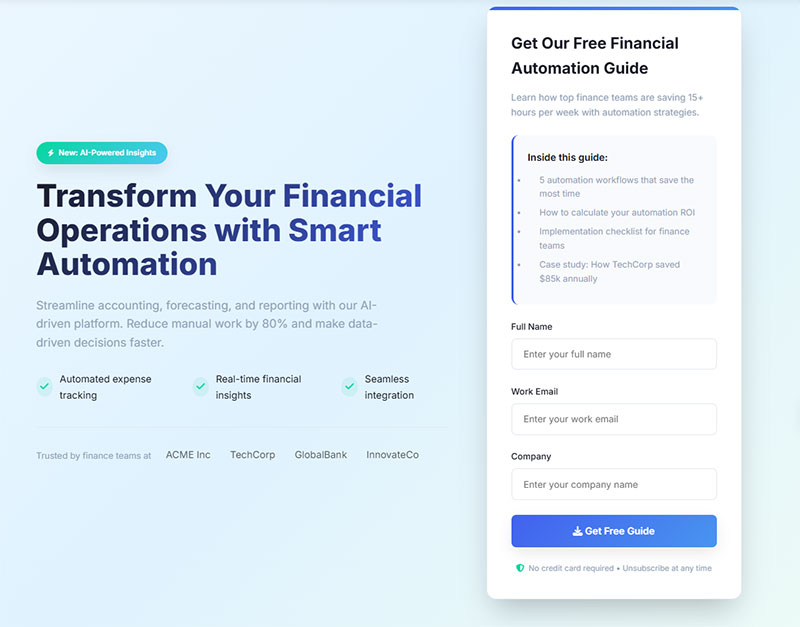
Gated content requires strategic thinking.
Core Implementation
Gate resources that provide substantial value worth trading an email address to access. Offer preview content or sample pages to demonstrate quality before requiring opt-in. Make the value proposition crystal clear before asking for contact information. Consider progressive gating where basic resources are free and advanced materials require registration.
Impact on Conversion
Appropriate gating balances list growth with user experience. Over-gating low-value content frustrates visitors and damages brand perception. Under-gating means missing list building opportunities. The perceived value must match or exceed the “cost” of providing an email address.
Common Mistakes
Gating obvious information freely available elsewhere. Requiring extensive form completion for minimal value resources. Hiding all content behind forms without giving prospects any preview of quality. Using identical gating strategy for top-of-funnel and bottom-of-funnel resources.
Follow Up Promptly
The lead magnet is just the beginning.
Core Implementation
Send a welcome email sequence starting within 24 hours of delivery. Provide additional related value rather than immediately pitching products. Segment subscribers based on which lead magnet they downloaded to personalize follow-up messaging. Map out a 5-7 email nurture sequence that guides from problem awareness to solution consideration.
Impact on Conversion
Companies with systematic follow-up report 25-35% higher conversion rates than industry benchmarks. The lead magnet opens a conversation, but subsequent emails build the relationship that drives purchases. Timely, relevant follow-up capitalizes on initial interest before it fades.
Common Mistakes
No follow-up strategy beyond adding people to a generic newsletter. Waiting weeks before the next contact, allowing momentum to die. Immediately pushing sales without establishing additional value first. Sending identical messages to all subscribers regardless of which resource they downloaded or what problem they’re solving.
Technical Requirements
Email service provider with automation and segmentation capabilities. Pre-written email sequences ready to deploy. Tagging system to organize subscribers by lead magnet source and interests.
Track Conversion Metrics
Guessing kills optimization efforts.
Core Implementation
Monitor landing page conversion rate (form submissions divided by visitors). Track email opt-in form completion rates and field abandonment points. Measure cost per lead if using paid traffic. Calculate downstream metrics like subscriber-to-customer conversion rate by lead magnet type. Review engagement metrics including email open rates and click-through rates for follow-up sequences.
Impact on Conversion
Data reveals what’s actually working versus assumptions. Small optimizations based on metrics compound over time. Tracking shows which lead magnets attract qualified buyers versus curiosity seekers. Measurement enables continuous improvement rather than static campaigns.
Common Mistakes
Only tracking vanity metrics like total downloads without measuring quality. Failing to connect lead magnet performance to actual revenue and customer acquisition. Making changes without establishing baseline metrics first. Analyzing data once at launch then never reviewing again.
Optimization Criteria
Set benchmarks based on industry standards (average landing page conversion around 6.6%, top performers exceed 10%). Compare your performance across different lead magnets and formats. Track trends over time rather than single snapshots. Correlate lead source with customer lifetime value.
FAQ on Lead Magnet Best Practices
What makes a lead magnet effective?
An effective lead magnet solves one specific problem immediately. It should be consumable within 5-10 minutes, deliver actionable value, and align with your main offer.
Short-form content like checklists convert at 34% while generic resources struggle below 10%. Quality and relevance matter more than length.
How many form fields should I use?
Limit your email opt-in form to name and email only. Each additional field reduces conversions by 5-10%.
Professional services might justify asking job title or company size, but most businesses sacrifice leads by requesting unnecessary information. Test removing fields to see immediate conversion improvements.
Should I use video or written lead magnets?
Both formats perform well—24% of marketers favor video, 23% prefer written content. Your audience determines the winner.
Test both with your specific market. B2B audiences often prefer written guides while B2C responds better to video tutorials. Short-form content outperforms long-form in both categories.
How do I optimize my landing page for conversions?
Remove navigation menus to eliminate exit paths. Place your opt-in form above the fold with a benefit-driven headline.
Use bullet points highlighting what’s included, add social proof numbers, and ensure mobile responsiveness. Average landing page conversion rates hit 6.6%, but optimized pages reach 18% or higher.
What’s the best lead magnet format for my industry?
Checklists and templates work universally across industries. SaaS companies see success with calculators and free trials.
E-commerce performs well with discount codes and product guides. Professional services benefit from case studies and assessment tools. Test multiple formats rather than assuming one works best.
How quickly should I deliver the lead magnet?
Instantly. Automated delivery within 60 seconds maintains momentum and trust.
Delays reduce conversions and increase abandonment. Companies with systematic follow-up processes see 25-35% better performance than those with delayed fulfillment. Use marketing automation to trigger immediate sending.
Do I need different lead magnets for different audience segments?
Yes, when targeting distinct buyer personas with different pain points. Create specific resources for each segment rather than generic one-size-fits-all content.
Segment by industry, role, or problem type. This approach attracts qualified prospects who actually convert to customers instead of building large lists with poor engagement.
How do I measure lead magnet success?
Track landing page conversion rate, email open rates, and subscriber-to-customer conversion. Monitor engagement metrics like completion rates and follow-up click-throughs.
The critical metric is how many leads become paying customers, not just download volume. Connect lead magnet performance to actual revenue using your analytics dashboard.
Should all content be gated?
No. Gate substantial resources worth trading an email address to access. Leave blog posts and basic information ungated.
Preview sample pages before requiring opt-in to demonstrate value. Over-gating frustrates visitors while under-gating misses list building opportunities. Balance accessibility with strategic conversion points.
What mistakes kill lead magnet conversions?
Trying to solve multiple problems instead of focusing on one specific issue. Requiring too many form fields or email verification before delivery.
Creating long resources people won’t consume. Misaligning the lead magnet with your actual products. Delayed delivery and poor follow-up sequences. Generic content available elsewhere for free.
Conclusion
Implementing lead magnet best practices transforms your subscriber acquisition strategy from guesswork into a predictable system. The difference between 3% and 34% conversion rates comes down to strategic execution, not luck.
Focus on solving specific problems your target audience actually faces. Keep resources short and actionable—nobody wants another unread 40-page PDF sitting in their downloads folder.
Your landing page design matters as much as the content itself. Remove friction from the opt-in process, deliver value instantly, and follow up with nurture sequences that build relationships.
Test different formats to discover what resonates with your market. Track conversion metrics beyond vanity numbers like total downloads.
The businesses winning at email list building aren’t creating more content. They’re creating better content that aligns with their customer acquisition goals and sales funnel strategy.
Start with one optimized lead magnet. Perfect it, measure results, then scale what works.
